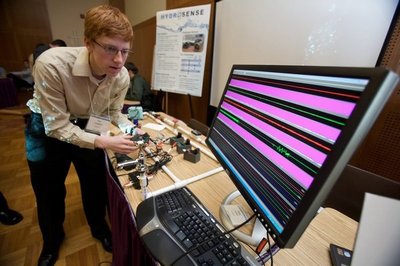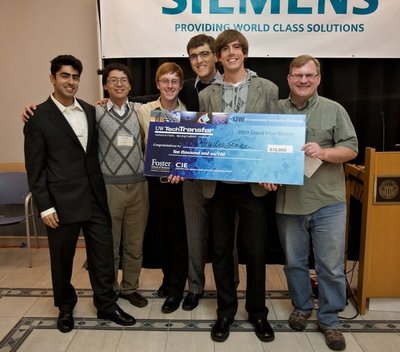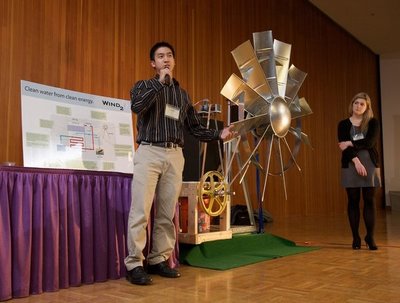April 9, 2009
Student teams win cash for finding solutions to real-world environmental problems
What do you get when you combine engineers, entrepreneurs and environmental experts? A host of innovative, clean-tech solutions to real-world environmental problems and the business plans to back them up.
Sixteen interdisciplinary student teams presented these sustainable, market-savvy solutions at the UW’s inaugural Environmental Innovation Challenge (EIC) on April 1.
The EIC was launched in fall 2008 with a two-credit “Environmental Innovation Practicum” course, which was cross-listed in business, engineering and the Program on the Environment to attract undergraduate and graduate students from a range of backgrounds. The course, taught by entrepreneurship lecturer Emer Dooley, hosted several guest lecturers to speak on specific environmental problems and approaches to innovation, technology commercialization and more.
Students ultimately wrote a final paper that defined a water-related environmental problem and outlined potential solutions. They were encouraged to form teams to compete in the EIC for a chance to win the $10,000 grand prize, furnished by UW TechTransfer.
The challenge’s theme was Clean Tech, with the option for an emphasis on water, and teams could choose any problem to target. Teams had to develop a proof-of-concept, prototype or simulation, as well as a business summary that demonstrated well-formulated business models with significant potential for growth.
“The role of the class was to get everybody to start thinking about this, but the secondary role was for people with similar interests to meet each other,” said Connie Bourassa-Shaw, director of the Center for Innovation and Entrepreneurship in the Foster School of Business, which co-founded the challenge with the Applied Physics Laboratory. “By talking in the class and working on projects together, students really started to develop some trust and some respect for each other’s capabilities, and that’s really what has to happen.”
Members of the winning team, HydroSense, met while taking the course, and Bourassa-Shaw said their synergy and diversity were key factors in their success.
“[Project lead] Jon Froehlich is a computer science and engineering Ph.D. student, but he surrounded himself with other engineering students, a couple of undergrads, and the team was huge — but everybody played a role in this,” Bourassa-Shaw said. “I think the end product, HydroSense, is a different idea, a different project than it would have been if it had just been Jon going the whole way through alone.”
Team HydroSense created a sensor of the same name that screws onto a single water bib or faucet and uses the analysis of acoustic, vibration and pressure differential signatures of water flow to determine usage.
The sensor can calculate real-time water flow and automatically detect leaks and pipe ruptures, giving consumers a way to track their water usage and be alerted to costly problems. The team projected a 10 to 25 percent reduction in home water usage and savings of $50 to $120 a year for one household. Click here to see a video demonstration of the sensor.
Froehlich said HydroSense started as a research project for his doctoral dissertation. “My dissertation is broadly about using modern advances in computing to sense our everyday lives in unique ways,” he explained, “and then relating that sensed information back to the user in a way that stimulates thought and/or promotes certain behaviors.”
“I think there’s an opportunity to change people’s behavior based on knowledge,” said Janis Machala, director of LaunchPad Services for UW TechTransfer and a judge for the challenge. “Everyone realizes that they’re wasting water at the concept level, but it helps when you can see how much you are really wasting in terms of dishwater or showers and be able to look at it on a room-by-room basis.”
Team HydroSense was made up of Froehlich and Kate Everitt, both doctoral students in computer science and engineering; Tim Campbell, an undergraduate in mechanical engineering; Alex Horton, an undergraduate in electrical engineering; Jianlei Shi, a doctoral student in electrical engineering; Rahber Thariani, a doctoral student in bioengineering; and Conor Haggerty, an undergraduate in environmental planning.
Not all of the teams focused on water. In fact, team Nanocel took the second-place, $5,000 prize, sponsored by Davis Wright Tremaine, by targeting the problem of heat density in electronics.
As electronics increase in power and decrease in size, they are more likely to fail due to overheating. Nanocel created a plastic heat sink that contains a convective flow of fluid to remove heat from electronics faster than metal and silicon heat sinks. The product cools electronics efficiently, allowing further miniaturization of electronics and reducing the amount of hazardous materials that need to be used to make them.
Three honorable-mention prizes of $2,500 went to Wind20, which used wind energy and mechanical vapor compression to purify and desalinate dirty water for drinking; InTheWorks, which created the AquaCat, a catalytic converter that eliminates more than 99 percent of emissions from gasoline marine engines; and Ecowell, a team from Washington State University that developed vending kiosks that can dispense inexpensive, purified hot, cold or sparkling water to customers’ reusable containers using prepaid accounts.
The challenge’s 78 judges came from organizations like Conservation International, the Washington State Department of Ecology and the Pacific Science Center, as well as companies such as Siemens, Teledyne and Starbucks. Their job was to evaluate the teams based on their product’s viability, potential market size and breadth of impact.
“It is not enough to have a cool idea — somebody’s got to buy it, and that’s what makes the environmental impact real,” said Bourassa-Shaw.
The next step for teams that want to move forward with their innovations is to refine them for the UW Business Plan Competition, the marquee event for the Center for Innovation and Entrepreneurship, Bourassa-Shaw said.
“They need to refine the idea, take in all the criticism and feedback they got from the judges, and they need to rework their executive summary so it is more of a business summary and not just an environmental innovation summary,” she explained. “They’ll have to beef up the financials, and they’ll have to start talking about traction.”
Machala said UW TechTransfer is interested in working with some teams to turn their ideas into reality.
“We’re very interested in technology transfer of environmental products and services,” she said. “I’ve met some very talented students here, and I think there are some really viable businesses here that could be start-ups, so our interest is if we can transfer that technology into a commercial arena.”
Froehlich said nearly all of the $10,000 prize will go back into the HydroSense project. “We are delighted with the reception HydroSense is receiving from the entrepreneurial community,” he said. “We have been in contact with UW TechTransfer, even before the EIC competition took place, and they are working with us to manage certain pragmatic aspects of the project.”
The success of the EIC already has Bourassa-Shaw thinking about next year’s competition. “The thing I want to do next year is open this up to other colleges and universities around the state,” she said. The EIC was not limited to the UW this year, but only one team and a few team members came from other schools.
“We also need to make sure that we continue to involve the College of the Environment and the College of Engineering to help us get the word out about the UW EIC. Faculty champions across campus can say to their classes, ‘This is a terrific opportunity — you guys should be doing this,'” Bourassa-Shaw said.
The EIC’s theme will remain Clean Tech, with an optional emphasis on something more specific. Possibilities for next year’s emphasis are energy and green building.
“I’ll tell you one thing — we will be back next year,” said Bourassa-Shaw. “This event is amazing, and it has the ability to grow big.”



